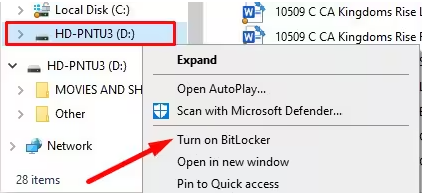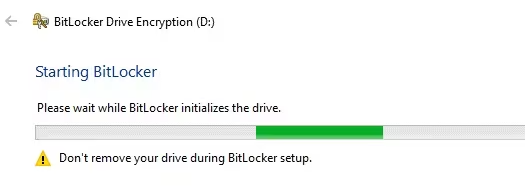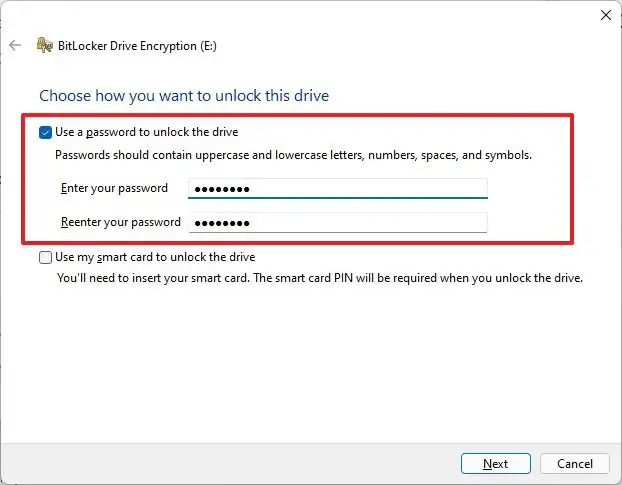What is a BitLocker to go USB and how does one utilize it? If you wish to establish a BitLocker to go USB for your portable devices, then this guide will assist you in comprehending BitLocker to go.
The BitLocker security utility is a Windows application that encrypts and protects the data that is stored on your computer. You have the option of encrypting the entire drive or just the space that is currently being used. On the other hand, it is not limited to protecting the data that is stored on your hard disk. Additionally, it comes with a function that encrypts and safeguards data stored on removable hard drives and USB flash drives. This feature is known as BitLocker to Go, and it is compatible with Windows 10 and.
Drive encryption software known as BitLocker to Go is compatible with a variety of file systems, including NTFS, FAT16, FAT32, and exFAT. In addition to other kinds of drives, it is designed to safeguard USB flash drives, SD cards, external hard drives, and other types of devices. When a drive is encrypted, the data can only be accessed by using a recovery key, a password, or a smart card on another computer. If the drive is not encrypted, the data cannot be accessed.
Note: BitLocker to Go requires enabled BitLocker on your machine. Go to Control Panel, then System and Security. BitLocker Drive Encryption is the bottom security option. Press it to activate. To ensure Windows compatibility, the system will scan quickly.
Step 1. Plug the USB flash drive into your computer.
Step 2. Open your Windows Explorer window and find your removable hard drive. Right-click on the icon and a box will open. Press Turn on BitLocker.

The software will automatically initialize on your drive.

Step 3. Create a secure password and confirm it, then press the Next button.

You can back up the recovery key by saving it to a file or printing it. If you choose to save it to a file, it can't be on an encrypted drive. When you're done, press the Next button.

Choose how much of the drive you want to encrypt. The two options are only the used space or the entire drive.
Pick your preferred encryption mode. The choices will vary based on your version of Windows, but the setup wizard clearly explains which mode is best for each situation.
Once your settings are complete, press the Start Encrypting button, and BitLocker will begin securing your drive data. Do not disconnect the drive while the encryption process is running, or it can damage the files on the drive.
To unlock your USB flash drive, you will need to input your password after it has been encrypted. The procedure is exceedingly straightforward. Ensure that you possess the password that was generated during the encryption of the drive.
Step 1. Plug in the USB flash drive. A dialog box will open with a prompt to enter the password.
Step 2. Type the password in the field and press the Unlock button.
The drive will unlock, and you will have unlimited access to your files.
To change your password, you can make use of the recovery key that you either printed out or saved to a file when you encrypted the drive.
Step 1. Plug in the USB flash drive and the dialogue box will open.
Step 2. Instead of entering the password in the space provided, click the More Options link.
For those who have elected to save the recovery key in a file, the key can be easily copied or pasted by opening the file. The 48-digit code must be entered if it was printed. Press the "Unlock" button when you have finished.
Step 3. Open BitLocker through the Control Panel. Click on the Change Password link, and a dialogue box will open. Enter and confirm your new password and press the Change Password button.
Go to the Windows menu, type "Manage BitLocker" and click on its shortcut to access the BitLocker configuration.
Inside the BitLocker configuration panel, click on the "Turn off BitLocker" option, this and other options related to BitLocker are next to the icon and name of the drive that you've encrypted.
A pop-up window will appear asking you to confirm the BitLocker disabling process. Click on "Turn off BitLocker". Then, the BitLocker encryption is successfully removed from your USB drive.
Unfortunately, users of Windows 11 and Windows 10 Home do not have the option to encrypt their sensitive data with BitLocker. So, if you are a Windows Home user but wish to use BitLocker to encrypt your portable devices, you’ll need another solution: AOMEI Partition Assistant Professional.
It is a dependable and secure encryption instrument that facilitates the encrypting and management of BitLocker with greater efficiency.
Step 1. Install and launch AOMEI Partition Assistant Professional.
Step 2. Navigate to the "Tools" tab and select "BitLocker".
Step 3. All drives on the system will be displayed. Please Select the drive partition you want to encrypt and click "Turn on BitLocker".
Step 4. Set a password, confirm, and click "Next" to continue.
Step 5. Select a preferred way to back up your recovery key: "Save to a file" or "Print the recovery key".
Please keep the file carefully.
Step 1. Access the encrypted drive and select "Back up recovery key".
Step 2. Enter your password and click "Next" to continue.
Step 3. Select "Save to a file" or "Print the recovery key".
Step 4. Click "Next" to save the recovery key in the generated TXT file.
Make sure that the file containing the recovery key is kept secure and easily accessible to BitLocker administration.
Step 1. Locate the drive you want to change the password. Click the "Change password" option.
Step 2. Select your preferred method: "Use password to change drive password" or "Use recovery key to change drive password".
Step 3. The confirmation "Password changed successfully" window shows that the password was changed successfully.
If a drive is not locked, click the option "Lock the drive" to lock the drive directly.
To unlock a USB, refer to these steps:
Step 1. Click"Unlock the drive".
Step 2. Select a preferred way: "Use a password to unlock the drive" or "Use a recovery key to unlock the drive". Then click "Unlock".
The drive will be unlocked if the entered password/recovery key is correct.
Step 1. Find the encrypted drive and click "Turn off BitLocker".
Step 2. Time to wait for decryption to complete. Please do not terminate the program, remove the drive, or turn off the power.
Step 3. Once the decryption process is finished, click "Completed".
The data on the USB flash drive is encrypted with either 128-bit or 256-bit encryption. The data cannot be decrypted or unlocked in the absence of the recovery key or password. The initial step is to attempt to locate the recovery key. When you encrypted the drive, you were presented with two options:
Save it as a file.
The recovery key should be printed.
Check your Microsoft account or any folders that may contain the key if you have saved the file. If you have printed the copy, locate the paper and trust that you have not discarded it as scrap paper.
Another option is to verify whether the password was retained on the drive during the sign-in process, provided that you have a password manager.
If the recovery key is unavailable and the password is forgotten, there is no alternative method for retrieving the data. If you continue to desire to utilize the flash drive, you may reformat it, which will eliminate all of the data stored on the device. You will also be able to utilize the drive after the encryption is removed.
Plug the USB flash drive into your computer
Open the File Explorer folder.
Find the removable drive on the left-hand panel. Right-click your mouse to open the menu options and click on the Format option.
The options menu will open. Keep the default NTFS file system option if you're only planning on using the USB drive on a PC. However, if you want the drive to be compatible with macOS as well, you should select the exFAT option.
Press the Start button and then confirm that you want to format the drive and lose all the data.
If you don't want to lose data on the formatted locked BitLocker USB, you can try the Data Recover of AOMEI Partition Assistant to retrieve lost data. The "Recover Data" function is capable of recovering a wide range of file types from a variety of storage media and is compatible with Windows versions 11.1/10/8/8.1/7. It is capable of recovering deleted documents, images, emails, and other data from a variety of storage devices, including HDDs, SSDs, SD cards, and USB drives.
Encrypting data on external hard drives, USB flash drives, and SD cards is a breeze with BitLocker to Go. Nevertheless, you must select a password that you can easily recall and keep the recovery key in a secure location. If you neglect the password and lose the recovery key, you will be unable to access the data on the drive. With AOMEI Partition Assistant Professional, Windows Home users can also use BitLocker encryption on their PC and USB drive. This robust tool also carries all BitLocker features for Home users, you can easily protect your privacy.
Whar's more, if any data loss during your BitLocker management, the Data Recover function in this tool can save your data too. In addition, this tool has disk cloning, MBR/GPT conversion, disk check, app movers, PC cleaner, and many handy functions to help you manage your computer, and there is the Server edition for Windows Server 2025/2022/2019/2016/2012 users to organize Server resources much efficiently.